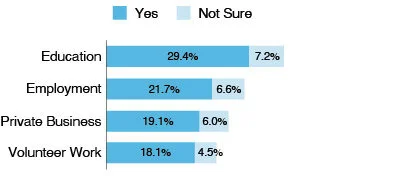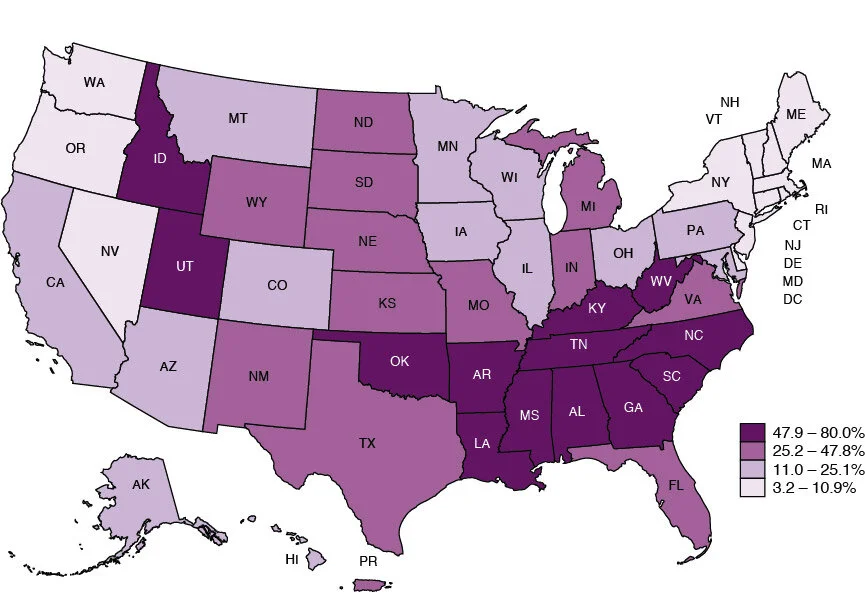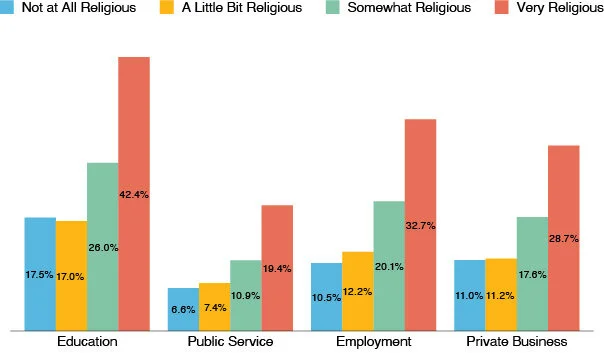Executive Summary
Background
Since the founding of the United States, nonreligious people have been an important, but too often invisible, segment of American society. Despite the fact that they make up a significant and growing percentage of the population, we know remarkably little about nonreligious people and communities.
The 2019 U.S. Secular Survey was an effort to address that gap – a groundbreaking survey of nearly 34,000 nonreligious people living in the United States. This survey brought together atheists, agnostics, humanists, freethinkers, skeptics, and others to provide essential data about our communities, our priorities, and our lives.
Reality Check is the first report that American Atheists is publishing from this important data set, intended to provide an overview of what we learned about nonreligious people in America and to show significant differences across regions and communities.
Identity & Concealment
People with many different nonreligious identities participated in the U.S. Secular Survey, including atheists, agnostics, humanists, skeptics, freethinkers, and people who simply identified as secular or nonreligious. More than half (57.1%) of participants most strongly identified as atheists, and the vast majority of participants (94.8%) identified as atheists to at least some extent. The second most prevalent primary identity was humanists (14.2%), and significantly fewer participants primarily identified with other labels. Despite stereotypes about how religious upbringing affects nonreligious people, participants had fairly diverse religious backgrounds. One in seven (14.3%) participants were raised in a nonreligious household and about the same number (14.3%) had very strict religious expectations growing up.
As with other invisible minorities, we found that nonreligious people frequently conceal their nonreligious identities and beliefs in various contexts, particularly when they are likely to face stigmatization or discrimination. Nearly one third (31.4%) of participants mostly or always concealed their nonreligious identity from members of their immediate family. Nearly half of participants mostly or always concealed their nonreligious identity among people at work (44.3%) and people at school (42.8%).
Primary Nonreligious Identity
In the small city I am from, religion is a way of life, and anyone who comes along who doesn’t toe the line is scary, and when people fear you unjustly, they can justify doing horrible things to you. It’s scary to be an atheist in a small town. We need more groups to not just be activists on the big issues, but we need to teach people how to be community leaders and provide tangible services to people. We need to teach them how to build safe communities that people can turn to when they lose everything after leaving religion. We need more groups that serve the emotional needs of the nonreligious in their community, that are helping on a local and individual scale.
— Female, Texas
Discrimination & Stigma
Tragically, we found that participants faced a high level of family rejection as a result of their nonreligious identity. Among participants under age 25, one in five (21.9%) reported that their parents are not aware of their nonreligious beliefs. For those whose parents are aware of their nonreligious identities, nearly one third (29.2%) have parents that are somewhat or very unsupportive of their beliefs. We found that family rejection had a significant negative impact on participants’ educational and psychological outcomes. For example, participants with unsupportive parents had a 71.2% higher rate of likely depression than those with very supportive parents.
Nonreligious people in the United States live in a deeply religious culture where their beliefs are frequently stigmatized. We found that nonreligious people routinely face discrimination and stigma because of their nonreligious identity. Nearly one third (29.4%) of participants had negative experiences in education due to their nonreligious identity, and one in five (21.7%) had negative experiences at work.
Negative Experiences & Discrimination
The U.S. Secular Survey also measured exposure to stigma based on participants’ nonreligious identity by asking how frequently they encounter various stigmatizing incidents. Perhaps contributing to the frequent concealment of their nonreligious identities, nearly half (47.5%) of survey participants were sometimes, frequently, or almost always asked or felt pressure to pretend that they are religious. Because of the discrimination and stigmatization nonreligious people face in our society, they experience heightened rates of loneliness and depression. Our research shows that one in six (17.2%) of survey participants are likely to be depressed and about one quarter (25.6%) of participants often experience one or more indicators of loneliness and social isolation.
Notably, the level of discrimination and stigmatization was dramatically higher for participants living in very religious areas. Survey participants were asked to assess how religious people in their communities are; nearly one third (29.8%) of participants live in very religious communities. Participants from rural locations (49.6%) and small towns (42.7%) were more likely to say their current setting was very religious than those from other settings (23.7%).
Percentage of Very Religious Communities by State
Nonreligious participants living in very religious communities were nearly 2.5 times more likely to experience negative events in education than in nonreligious communities, nearly 2.5 times more likely to experience negative events in public services (for example, voting, jury duty, poll work), more than 3 times more likely in employment, and more than 2 times more likely when dealing with private businesses. Moreover, participants living in very religious communities experienced nearly 40% more stigma than those in not at all religious communities.
Community Religiosity and Increased Discrimination
Stigma and Community Religiosity by State
Several subpopulations of nonreligious people face unique additional discrimination and stigma because of their race or religious upbringing, and others have unique experiences which required further analysis. While this report provides an initial look at the data for these subpopulations of nonreligious people, American Atheists intends to separately publish a more detailed analysis on these communities.
Because of their nonreligious beliefs:
Black participants were 1/2 as likely to have supportive parents and 3x as likely to be physically assaulted.
Ex-Muslim participants were 2x as likely to experience negative interactions with police and court systems.
Among nonreligious servicemembers and veterans, nearly 1/2 had negative experiences during their service.
Young people were 5x as likely to be physically assaulted 3x as likely to be depressed.
Policy Priorities
Survey participants were asked to identify the three more important issues that organizations representing nonreligious people should prioritize. More than half (51.9%) of all participants expressed that maintaining secular public schools should be one of the key issues prioritized. We also found that in states with strong protections for religious equality, nonreligious people on average faced a lower level of stigma.
Policy Priorities for Secular Organizations
Involvement with the Secular Movement
A significant percentage of participants were involved with Secular Movement activities, ranging from membership in national organizations to participation in local groups and activities. More than one in five (22.1%) participants were involved with a local secular organization. Moreover, there was a widespread interest among participants in participating in advocacy, community, educational and service activities organized by local organizations.
Most notably, 72.2% of participants with children were interested in additional nonreligious resources for people with children. We also found that involvement with Secular Movement organizations was a protective factor that correlated with reduced loneliness and likely depression. For example, members of national organizations were more than one third (34.8%) less likely than nonmembers to screen positive for depression (13.4% vs. 19.2%).







